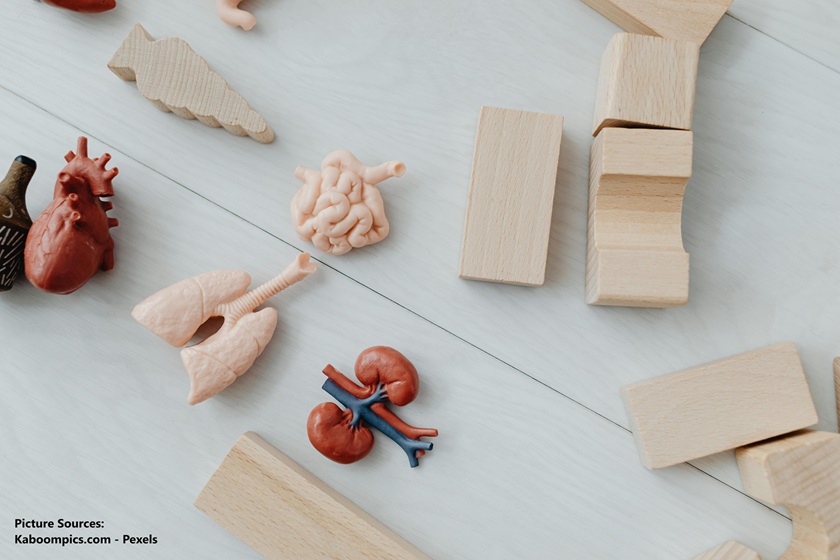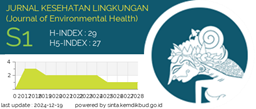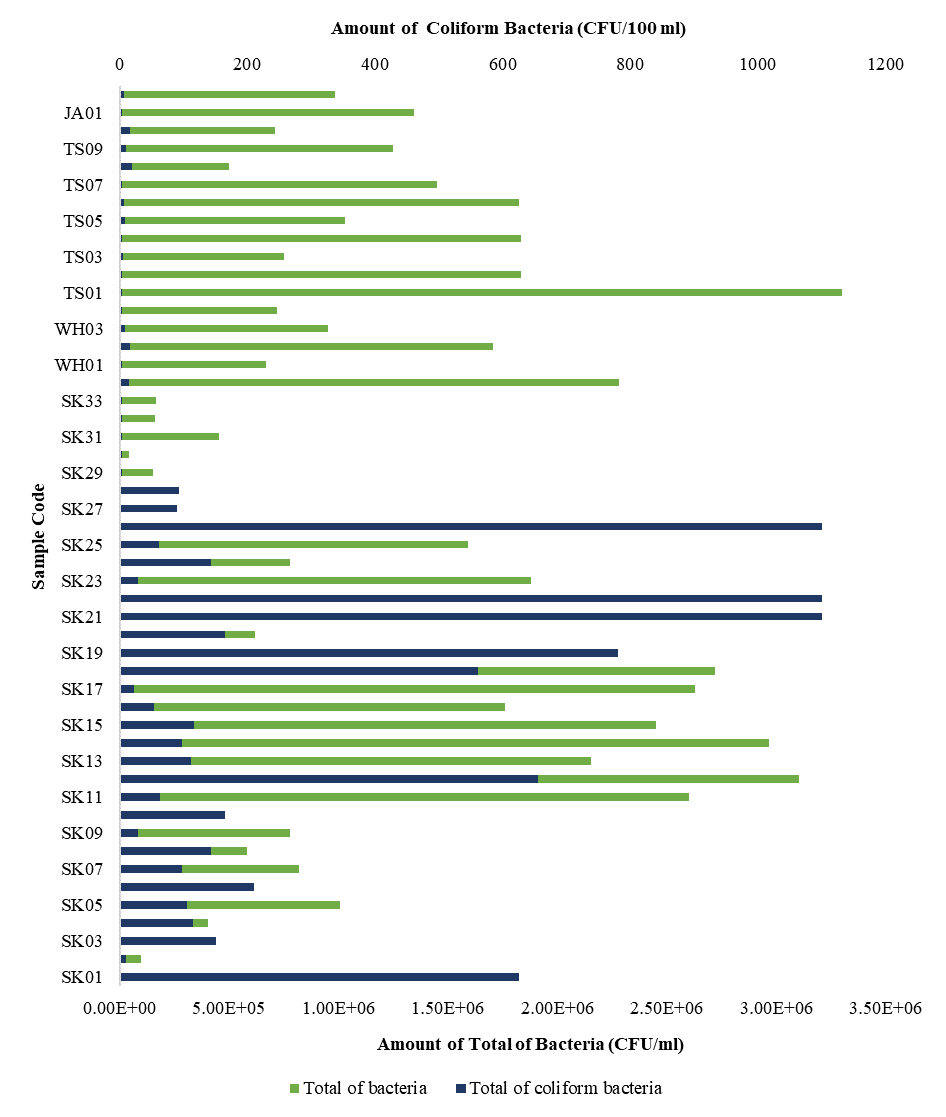Effect of Mercury Administration as an Oxidative Stress Trigger in Hepato-Renal Injuries

Introduction: Mercury as the source of free radicals can trigger the activation of oxidative stress pathways. With its high toxicity, it can cause hepato-renal injuries. There have been many studies on mercury toxicity in various organs, but there are still few scientific studies that examine the hepato-renal injuries caused by mercury through the oxidative stress pathway. This study was conducted to investigate the triggering of the oxidative stress pathway due to mercury exposure in hepato-renal injuries. Methods: Research using randomized true laboratory experiment method with post-test control group design. The number of samples used was 28 Wistar rats. The research group consisted of 2 groups, control group was given aquadest ad libitum, and intervention group was given water contaminated with mercury per oral once a day (15 kg/WB). The treatment period was 14 consecutive days and on the 15th day, blood samples were taken. Oxidative stress marker was assessed by examining MDA and GPx levels and hepato-renal injuries were assessed by examining liver function (ALT and AST) and kidney function (ureum and creatinine). The collected data were analyzed by independent t-test with 95% confidence level; significant if p>0.05. Results and Discussion: The study found that mercury can trigger the activation of oxidative stress pathways and have an impact on hepato-renal function. Conclusion: Research still needs to be continued to prove that impaired hepato-renal injuries also occur at the cellular histomorphologic and discover other biomolecular mechanisms such as activation of inflammatory pathways that can also cause organ damage.
Onan E, Ulu S, Güngör Ö. Heavy Metals and Kidney. Turkish J Nephrol. 2024;33(3):244–251. https://10.0.20.32/turkjnephrol.2024.22497
Javaid A, Akbar I, Javed H, Khan U, Iftikhar H, Zahra D, et al. Role of Heavy Metals in Diabetes: Mechanisms and Treatment Strategies. Crit Rev Eukaryot Gene Expr. 2021;31(3):65–80. https://doi.org/10.1615/CritRevEukaryotGeneExpr.2021037971
Ali SS, Elsamahy T, Al-Tohamy R, Zhu D, Mahmoud YAG, Koutra E, et al. Plastic Wastes Biodegradation: Mechanisms, Challenges and Future Prospects. Sci Total Environ. 2021;780(1):146590. https://doi.org/10.1016/j.scitotenv.2021.146590
Ali SS, Abdelkarim EA, Elsamahy T, Al-Tohamy R, Li F, Kornaros M, et al. Bioplastic Production in Terms of Life Cycle Assessment: A State-of-the-Art Review. Environ Sci Ecotechnology. 2023;15(1):100254. https://doi.org/10.1016/j.ese.2023.100254
Sarker A, Masud MA Al, Deepo DM, Das K, Nandi R, Ansary MWR, et al. Biological and Green Remediation of Heavy Metal Contaminated Water and Soils: A State-of-the-Art Review. Chemosphere. 2023;332(1):138861. https://10.0.3.248/j.chemosphere.2023.138861
Balali-Mood M, Naseri K, Tahergorabi Z, Khazdair MR, Sadeghi M. Toxic Mechanisms of Five Heavy Metals: Mercury, Lead, Chromium, Cadmium, and Arsenic. Front Pharmacol. 2021;12(1):643972. https://doi.org/10.3389/fphar.2021.643972
Ciacci C, Betti M, Abramovich S, Cavaliere M, Frontalini F. Mercury-Induced Oxidative Stress Response in Benthic Foraminifera: An in Vivo Experiment on Amphistegina lessonii. Biology (Basel). 2022;11(7):960. https://doi.org/10.3390/biology11070960
Wu YS, Osman AI, Hosny M, Elgarahy AM, Eltaweil AS, Rooney DW, et al. The Toxicity of Mercury and Its Chemical Compounds: Molecular Mechanisms and Environmental and Human Health Implications: A Comprehensive Review. ACS Omega. 2024;9(5):5100–5126. https://doi.org/10.1021/acsomega.3c07047
Indonesian Food and Drug Authority. Regulation of Indonesian Food and Drug Authority No. 18 year 2021 Preclinical Pharmacodynamic Testing Guidelines for Traditional Medicines. Jakarta: Indonesian Food and Drug Authority; 2021. https://peraturan.bpk.go.id/Details/181757/peraturan-bpom-no-18-tahun-2021
Kouam AF, Masso M, Kouoh FE, Fifen R, Njingou I, Tchana AN, et al. Hydro-ethanolic Extract of Khaya Grandifoliola Attenuates Heavy Metals-Induced Hepato-Renal Injury in Rats by Reducing Oxidative Stress and Metals-Bioaccumulation. Heliyon. 2022;8(11):e11685. https://doi.org/10.1016/j.heliyon.2022.e11685
Aranda-Rivera AK, Cruz-Gregorio A, Arancibia-Hernández YL, Hernández-Cruz EY, Pedraza-Chaverri J. RONS and Oxidative Stress: An Overview of Basic Concepts. Oxygen. 2022;2(4):437–478. https://doi.org/10.3390/oxygen2040030
Zheng F, Gonçalves FM, Abiko Y, Li H, Kumagai Y, Aschner M. Redox Toxicology of Environmental Chemicals Causing Oxidative Stress. Redox Biol. 2020;34(1):101475. https://doi.org/10.1016/j.redox.2020.101475
Saito K, Nakagawa M, Mandal M, Ishikita H. Role of Redox-Inactive Metals in Controlling the Redox Potential of Heterometallic Manganese-Oxido Clusters. Photosynth Res. 2021;148(3):153–159. https://doi.org/10.1007/s11120-021-00846-y
Paithankar JG, Saini S, Dwivedi S, Sharma A, Chowdhuri DK. Heavy Metal Associated Health Hazards: An Interplay of Oxidative Stress and Signal Transduction. Chemosphere. 2021;262(1):128350. https://doi.org/10.1016/j.chemosphere.2020.128350
Abdelazim AM, Abomughaid MM. Oxidative Stress: An Overview of Past Research and Future Insights. All Life. 2024;17(1):1-11. https://doi.org/10.1080/26895293.2024.2316092
Pisoschi AM, Pop A, Iordache F, Stanca L, Predoi G, Serban AI. Oxidative Stress Mitigation by Antioxidants - An Overview on Their Chemistry and Influences on Health Status. Eur J Med Chem. 2021;209(1):112891. https://doi.org/10.1016/j.ejmech.2020.112891
Touyz RM, Rios FJ, Alves-Lopes R, Neves KB, Camargo LL, Montezano AC. Oxidative Stress: A Unifying Paradigm in Hypertension. Can J Cardiol. 2020;36(5):659–670. https://doi.org/10.1016/j.cjca.2020.02.081
Singh D, Bist P, Choudhary S. Co-exposure to Multiple Heavy Metals and Metalloid Induces Dose Dependent Modulation in Antioxidative, Inflammatory, DNA Damage and Apoptic Pathways Progressing to Renal Dysfunction in Mice. Environ Toxicol Pharmacol. 2024;111(1):104537. https://doi.org/10.1016/j.etap.2024.104537
Lushchak VI, Storey KB. Oxidative stress concept updated: Definitions, Classifications, and Regulatory Pathways Implicated. EXCLI J. 2021;20(1):956–967. https://doi.org/10.17179/excli2021-3596
Zhao Y, Zhou C, Guo X, Hu G, Li G, Zhuang Y, et al. Exposed to Mercury-Induced Oxidative Stress, Changes of Intestinal Microflora, and Association between them in Mice. Biol Trace Elem Res. 2021;199(5):1900–1907. https://doi.org/10.1007/s12011-020-02300-x
Santacroce G, Gentile A, Soriano S, Novelli A, Lenti MV, Di Sabatino A. Glutathione: Pharmacological Aspects and Implications for Clinical Use in Non-Alcoholic Fatty Liver Disease. Front Med. 2023;10(1):1124275. https://doi.org/10.3389/fmed.2023.1124275
Pérez LM, Hooshmand B, Mangialasche F, Mecocci P, Smith AD, Refsum H, et al. Glutathione Serum Levels and Rate of Multimorbidity Development in Older Adults. J Gerontol A Biol Sci Med Sci. 2020;75(6):1089–1094. https://doi.org/10.1093/gerona/glz101
Ezejiofor AN, Orish CN, Akaranta O. Multi-Organ Inducedtoxicity of Metal Mixture (CdCl2, HgCl2, Pb(NO3)), and the Ameliorative Potentials of Plantain Musa paradisiaca (F. Musaceae) Stem Juice on Male Wistar Rats. Int J Physiol Pathophysiol Pharmacol. 2022;14(4):211–224. https://pubmed.ncbi.nlm.nih.gov/36161263/
Vieira JCS, Braga CP, Queiroz JV de, Cavecci-Mendonça B, Oliveira G de, Freitas NG de, et al. The Effects of Mercury Exposure on Amazonian Fishes: An Investigation of Potential Biomarkers. Chemosphere. 2023;316(1):137779. https://doi.org/10.1016/j.chemosphere.2023.137779
Bittarello AC, Vieira JCS, Braga CP, da Cunha Bataglioli I, de Oliveira G, Rocha LC, et al. Metalloproteomic Approach of Mercury-Binding Proteins in Liver and Kidney Tissues of Plagioscion squamosissimus (Corvina) and Colossoma macropomum (Tambaqui) from Amazon Region: Possible Identification of Mercury Contamination Biomarkers. Sci Total Environ. 2020;711(1):134547. https://doi.org/10.1016/j.scitotenv.2019.134547
Al Doghaither H, Elmorsy E, Al-Ghafari A, Ghulam J. Roles of Oxidative Stress, Apoptosis, and Inflammation in Metal-Induced Dysfunction of Beta Pancreatic Cells Isolated from CD1 Mice. Saudi J Biol Sci. 2021;28(1):651–663. https://doi.org/10.1016/j.sjbs.2020.10.056
Kang B, Wang J, Guo S, Yang L. Mercury-induced Toxicity: Mechanisms, Molecular Pathways, and Gene Regulation. Sci Total Environ. 2024;943(1):173577. https://doi.org/10.1016/j.scitotenv.2024.173577
Vig S, Lambooij JM, Zaldumbide A, Guigas B. Endoplasmic Reticulum-Mitochondria Crosstalk and Beta-Cell Destruction in Type 1 Diabetes. Front Immunol. 2021;12(1):1–10. https://doi.org/10.3389/fimmu.2021.669492
Jyothi NR. Heavy Metal Sources and Their Effects on Human Health. Rijeka: IntechOpen; 2020. https://doi.org/10.5772/intechopen.95370
Abu-Taweel GM. Effect of Administration of Mercuric Chloride on the Social Behavior, Neuromuscular Coordination, Motor Activity, Blood Parameters and Liver Structure Alterations in Mice Offspring. Pak J Zool. 2020;52(3):957–969. https://doi.org/10.17582/journal.pjz/20180711040734
Nabil A, Elshemy MM, Asem M, Gomaa HF. Protective Effect of DPPD on Mercury Chloride-Induced Hepatorenal Toxicity in Rats. J Toxicol. 2020;2020(1):4127284. https://doi.org/10.1155/2020/4127284
Yuliana I, Prenggono MD, Oktaviyanti IK, Ulfah F. The Effects of Heavy Metal Contamination on Liver Function in a Rat Model. MAGNA MEDICA. 2024;11(1):145–153. https://doi.org/10.26714/magnamed.11.2.2024.145-153
Peng R, Liu K, Li W, Yuan Y, Niu R, Zhou L, et al. Blood Urea Nitrogen, Blood Urea Nitrogen to Creatinine Ratio and Incident Stroke: The Dongfeng-Tongji cohort. Atherosclerosis. 2021;333(1):1–8. https://doi.org/10.1016/j.atherosclerosis.2021.08.011
Gao Z, Wu N, Du X, Li H, Mei X, Song Y. Toxic Nephropathy Secondary to Chronic Mercury Poisoning: Clinical Characteristics and Outcomes. Kidney Int Reports. 2022;7(6):1189–1197. https://doi.org/10.1016/j.ekir.2022.03.009
Han B, Lv Z, Han X, Li S, Han B, Yang Q, et al. Harmful Effects of Inorganic Mercury Exposure on Kidney Cells: Mitochondrial Dynamics Disorder and Excessive Oxidative Stress. Biol Trace Elem Res. 2022;200(4):1591–1597. https://doi.org/10.1007/s12011-021-02766-3
Vieira JV dos A, Marques VB, Vieira LV, Crajoinas R de O, Shimizu MHM, Seguro AC, et al. Changes in the Renal Function After Acute Mercuric Chloride Exposure in the Rat are Associated with Renal Vascular Endothelial Dysfunction and Proximal Tubule NHE3 Inhibition. Toxicol Lett. 2021;341(1):23–32. https://doi.org/10.1016/j.toxlet.2021.01.014
Barregard L, Sallsten G, Lundh T, Mölne J. Low-level Exposure to Lead, Cadmium and Mercury, and Histopathological Findings in Kidney Biopsies. Environ Res. 2022;211(1):113119. https://doi.org/10.1016/j.envres.2022.113119
Hazelhoff MH, Torres AM. Effect of Erythropoietin on Mercury-Induced Nephrotoxicity: Role of Membrane Transporters. Hum Exp Toxicol. 2021;40(3):515–525. https://doi.org/10.1177/0960327120958109
Zhang X, Zhang L, Cheng X, Liu S, Fang S, Zhang L, et al. Fluorescence Imaging to Probe Mercury Induced Oxidative Stress in Living Systems. Sensors Actuators B Chem. 2022;366(1):131982. https://doi.org/10.1016/j.snb.2022.131982
Yang L, Zhang Y, Wang F, Luo Z, Guo S, Strähle U. Toxicity of Mercury: Molecular Evidence. Chemosphere. 2020;245(1):125586. https://doi.org/10.1016/j.chemosphere.2019.125586
Jalili C, Kazemi M, Cheng H, Mohammadi H, Babaei A, Taheri E, et al. Associations between Exposure to Heavy Metals and the Risk of Chronic Kidney Disease: A Systematic Review and Meta-Analysis. Crit Rev Toxicol. 2021;51(2):165–182. https://doi.org/10.1080/10408444.2021.1891196

This work is licensed under a Creative Commons Attribution-NonCommercial-ShareAlike 4.0 International License.
1. Copyright of all journal manuscripts is held by the Jurnal Kesehatan Lingkungan.2. Formal legal provisions to access digital articles of electronic journal are subject to the provision of the Creative Commons Attribution-ShareAlike license (CC BY-NC-SA), which means that Jurnal Kesehatan Lingkungan is rightful to keep, transfer media/format, manage in the form of databases, maintain, and publish articles.
3. Published manuscripts both printed and electronic are open access for educational, research, and library purposes. Additionally, the editorial board is not responsible for any violations of copyright law.
JKESLING by UNAIR is licensed under a Creative Commons Attribution-ShareAlike 4.0 International License.







































